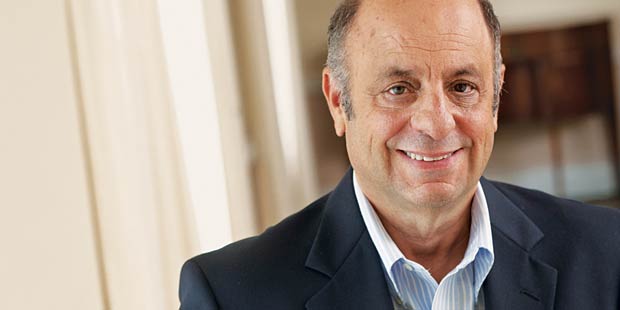The Consigliere of Mafia Prosecutions
Printer Friendly VersionThe catalogue of James B. Jacobs’s organized crime books is infused with a subtle sense of aggravated wonder about the criminal achievements of the Mafia. But his aggravation springs not so much from laws broken as from the fact that the Mob managed to maintain its illicit economic grip in so many cities for so long.
“This book is no exposé,” Jacobs, Chief Justice Warren E. Burger Professor of Constitutional Law and the Courts, pointedly writes in Gotham Unbound: How New York City Was Liberated from the Grip of Organized Crime (1999). It is no secret that the Mob’s corrupting hand has been deep in the pockets of big cities coast to coast since the 1920s, he says. Yet complicit or indifferent functionaries and politicians allowed the Mob to become intractable for generations before a series of relatively recent prosecutions in New York. “The same organized crime families have engaged in the same type of exploitation for much of the 20th century,” Jacobs notes in Mobsters, Unions, and Feds: The Mafia and the American Labor Movement (2006).
Jacobs sees some of the same indifference toward organized crime from his fellow scholars. Filling that void, he has crafted an unequaled scholarly corpus and essential historical record of modern Mob prosecutions. His five organized crime books—some coauthored with NYU Law students—feature lucid analysis of litigation and brisk histories of how the Mob flourished in such traditional strongholds as labor, trucking, construction, the garment industry, and waste hauling. In Gotham Unbound, he gently prods his peers: “We hope that this book will make it more difficult for urban scholars, whatever their discipline, to ignore the importance of organized crime in the 20th-century lives of American cities.”
Most popular Mafia books use the familiar narrative template of a colorful mobster taken down by a shrewd cop or a tenacious prosecutor. Jacobs does not write that sort of personalized history. Instead, he stacks one sturdy fact atop another, building a foundational record with extensive footnotes and references that will serve future scholars. He begins his treatment of each crime racket with a terse account of how and why organized crime had managed to thrive in a particular industry. In Gotham Unbound, for example, he describes how the Mafia’s corrupting grip on the Fulton Fish Market on the lower Manhattan waterfront was leveraged on two Mafia pillars: unions and transportation:
Workers, Smoked Fish and Cannery Union…. The Genovese crime family created loading and unloading cartels, maintained interests in some wholesaling companies, operated ‘security services,’ and organized and charged for parking…. As with the other mobbed-up industries examined in this book, Cosa Nostra functioned as a kind of legislature, court, and police force for the market. The rules covered competition, prices, labor relations, payoffs, and respect.”
Following an organizational template he uses in many of his books, Jacobs returns to the fish market later in Gotham Unbound to examine how organized crime was crowbarred out—in this case, with a combination of a federal racketeering prosecution and a new local law that added government oversight to the market’s operation. (Rudolph Giuliani ’68 was US attorney during the prosecution, and the law passed after he was elected mayor.) Jacobs is “a diligent and thorough researcher who tackles very complicated subjects and writes clear and engaging analyses,” says a former research assistant, Lauryn Gouldin ’00, assistant professor at Syracuse University College of Law.
Legal scholars agree that Jacobs has created an essential archive of key Mob prosecutions. “For two decades, he has produced detailed and careful case studies which are individually quite valuable and cumulatively provide a history of instrumental law enforcement of great importance,” Franklin Zimring of the University of California, Berkeley, School of Law says of Jacobs. “You can’t study this history without bumping into this cumulative bibliography around every new corner you turn.”
Jacobs began studying crime at the University of Chicago Law School, where he was a research assistant to Norval Morris, influential co-author of The Honest Politician’s Guide to Crime Control. Shortly after joining NYU Law in 1982, Jacobs was put in charge of analytics in an investigation of the mobbed-up New York construction industry by the NYS Organized Crime Task Force. That experience “redefined my career,” he says. “It put me on a set of issues about organized crime that I have stayed with.”
“No one had ever really had the academic entrepreneurial idea to record the accurate details of these organized crime investigations,” says a former student, C. Alexander Hortis ’99, a litigator with Venable in Baltimore. Jacobs contributed an introduction to Hortis’s 2014 book, The Mob and the City: The Hidden History of How the Mafia Captured New York.
Prolific and eclectic in his interests, Jacobs has written books on prisons, drunk driving, corruption, hate crime, and gun control. In 2012, Jacobs received a Guggenheim Foundation fellowship to work on a forthcoming book, The Eternal Criminal Record.
Jacobs says he feels compelled to return soon to his familiar themes, with possible projects on ethnic organized crime and more recent Mob prosecutions. The pool of material seems bottomless and, to Jacobs, the importance of his work is clear: “These [Mafia prosecutions] will be lost to history unless someone puts them on the record.”
The Gang of Five
Breaking the Devil’s Pact: The Battle to Free the Teamsters from the Mob (2011; with Kerry T. Cooperman)

Mobsters, Unions, and Feds: The Mafia and the American Labor Movement (2006)
Gotham Unbound: How New York City Was Liberated from the Grip of Organized Crime (1999; with Coleen Friel ’97 and Robert Radick ’97)
Busting the Mob: United States v. Cosa Nostra (1994; with Christopher Panarella ’94 and Jay Worthington ’01)
Corruption and Racketeering in the New York City Construction Industry (1991; with Ronald Goldstock, Martin Marcus, Thomas D. Thacher II)
—
